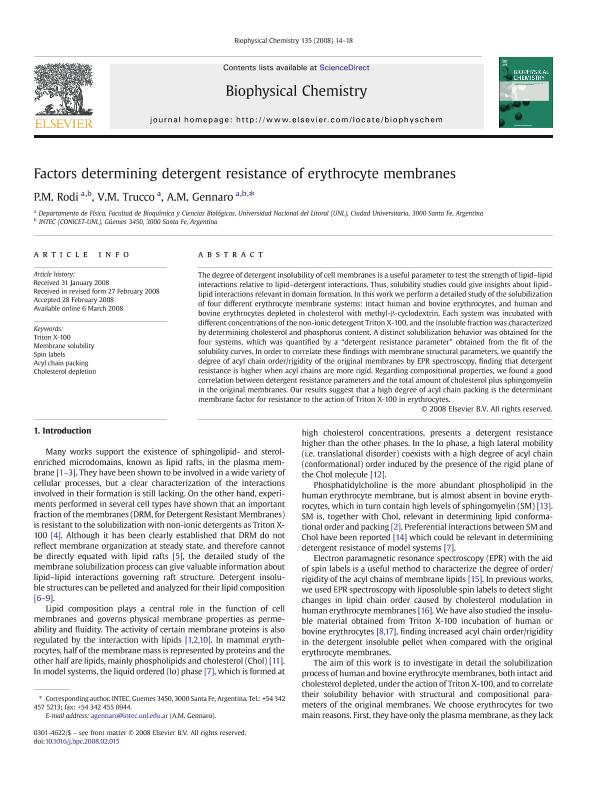Mostrar el registro sencillo del ítem
dc.contributor.author
Rodi, Pablo Marcelo

dc.contributor.author
Trucco, Verónica Milagros

dc.contributor.author
Gennaro, Ana Maria

dc.date.available
2017-09-21T19:06:38Z
dc.date.issued
2008-04
dc.identifier.citation
Rodi, Pablo Marcelo; Trucco, Verónica Milagros; Gennaro, Ana Maria; Factors determining detergent resistance of erythrocyte membranes; Elsevier Science; Biophysical Chemistry; 135; 1-3; 4-2008; 14-18
dc.identifier.issn
0301-4622
dc.identifier.uri
http://hdl.handle.net/11336/24825
dc.description.abstract
The degree of detergent insolubility of cell membranes is a useful parameter to test the strength of lipid–lipid interactions relative to lipid–detergent interactions. Thus, solubility studies could give insights about lipid–lipid interactions relevant in domain formation. In this work we perform a detailed study of the solubilization of four different erythrocyte membrane systems: intact human and bovine erythrocytes, and human and bovine erythrocytes depleted in cholesterol with methyl-â-cyclodextrin. Each system was incubated with different concentrations of the non-ionic detergent Triton X-100, and the insoluble fraction was characterized by determining cholesterol and phosphorus content. A distinct solubilization behavior was obtained for the four systems, which was quantified by a “detergent resistance parameter” obtained from the fit of the solubility curves. In order to correlate these findings with membrane structural parameters, we quantify the degree of acyl chain order/rigidity of the original membranes by EPR spectroscopy, finding that detergent resistance is higher when acyl chains are more rigid. Regarding compositional properties, we found a good correlation between detergent resistance parameters and the total amount of cholesterol plus sphingomyelin in the original membranes. Our results suggest that a high degree of acyl chain packing is the determinant membrane factor for resistance to the action of Triton X-100 in erythrocytes.
dc.format
application/pdf
dc.language.iso
eng
dc.publisher
Elsevier Science

dc.rights
info:eu-repo/semantics/openAccess
dc.rights.uri
https://creativecommons.org/licenses/by-nc-sa/2.5/ar/
dc.subject
Triton X-100
dc.subject
Membrane Solubility
dc.subject
Spin Labels
dc.subject
Acyl Chain Packing
dc.subject.classification
Otras Ciencias Físicas

dc.subject.classification
Ciencias Físicas

dc.subject.classification
CIENCIAS NATURALES Y EXACTAS

dc.title
Factors determining detergent resistance of erythrocyte membranes
dc.type
info:eu-repo/semantics/article
dc.type
info:ar-repo/semantics/artículo
dc.type
info:eu-repo/semantics/publishedVersion
dc.date.updated
2017-09-19T14:30:41Z
dc.journal.volume
135
dc.journal.number
1-3
dc.journal.pagination
14-18
dc.journal.pais
Países Bajos

dc.journal.ciudad
Amsterdam
dc.description.fil
Fil: Rodi, Pablo Marcelo. Consejo Nacional de Investigaciones Científicas y Técnicas. Centro Científico Tecnológico Conicet - Santa Fe. Instituto de Desarrollo Tecnológico para la Industria Química. Universidad Nacional del Litoral. Instituto de Desarrollo Tecnológico para la Industria Química; Argentina
dc.description.fil
Fil: Trucco, Verónica Milagros. Universidad Nacional del Litoral; Argentina
dc.description.fil
Fil: Gennaro, Ana Maria. Consejo Nacional de Investigaciones Científicas y Técnicas. Centro Científico Tecnológico Conicet - Santa Fe. Instituto de Desarrollo Tecnológico para la Industria Química. Universidad Nacional del Litoral. Instituto de Desarrollo Tecnológico para la Industria Química; Argentina
dc.journal.title
Biophysical Chemistry

dc.relation.alternativeid
info:eu-repo/semantics/altIdentifier/doi/http://dx.doi.org/10.1016/j.bpc.2008.02.015
dc.relation.alternativeid
info:eu-repo/semantics/altIdentifier/url/http://www.sciencedirect.com/science/article/pii/S0301462208000513
Archivos asociados
